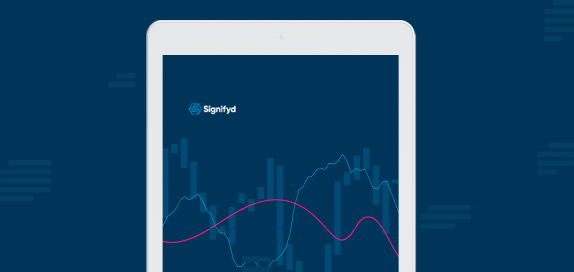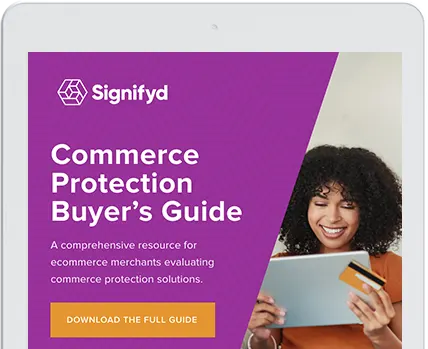Choosing a commerce protection solution with superior performance is critical both for protecting your business from online fraud and for approving more sales from genuine shoppers. In addition to minimizing false positives while catching the real villains, you’ll get a higher return on your investment in Merchant Fraud Protection. You’ll also ensure positive shopping experiences for customers, which will keep them returning for more.
But how can you identify the best-performing solution? This blog will present some important, and not-necessarily obvious tips gleaned from Signifyd’s Commerce Protection Buyer’s Guide on what to look for when shopping for a commerce protection platform.
How can merchants measure performance?
What do we mean by performance? Simply the ability to do the best all-around job. Start with fraud protection. Does the commerce protection platform authorize the right purchases? Maximize approval rates — in a transparent (and straightforward) way? Can it identify individual customers and therefore predict how they’re likely to behave? How accurate are its machine learning models for anticipating future fraud trends as well as providing protection from existing ones?
The real test, of course, is to evaluate vendors on the potential return on investment they provide for you. ROI manifests itself primarily in monetary returns (increases in bank authorization and order approval rates, reductions in order cancellations due to manual reviews, and chargeback-associated costs). You’ll also enjoy productivity returns, such as fewer manual review hours, fewer customer returns and fewer call center complaints.
Finally, the right solution will give you valuable customer-centric benefits, such as increases in customer lifetime value and Customer Satisfaction Scores (CSAT) — not to mention reductions in order fulfillment time and mistakenly declined orders.
Let’s look at what solution characteristics drive metrics like these.
Network size
First comes the network. How extensive is it? That is, from how many merchants is the vendor collecting transaction intelligence to feed into its AI and machine learning models? Size matters, because the bigger the vendor’s network, the broader range of bad behaviors — past, present and future — it is likely to catch. And the more legitimate orders it will recognize, even those that come with some red flags. You want a network that has the biggest market share among the top retailers in the world.
Network type
But also you should be concerned about what type of network the provider has built. There are two types: merchant-specific versus network models.
- Merchant-specific model: A merchant-specific model is one that focuses on data coming from an individual merchant’s ecommerce transactions. Although some merchant protection from chargeback providers claim that merchant-specific models are more accurate, these models possess significant blind spots. With such limited visibility into how fraud is evolving across ecommerce as a whole, merchant-specific models can only protect merchants from fraud they have personally experienced in the past. They fail to identify and predict the new types of fraud merchants will inevitably encounter now and in the future.
- Network model: A network model aggregates all the data coming from all the vendor’s customers, and flows that into its AI and machine learning algorithms to better identify and predict attempts at fraud. Shoppers who might be new to a given merchant are not new to the thousands of other merchants across the network. If the shopper has left a trail of fraud or abuse in their wake, the merchant can act before becoming the next victim. Conversely, if the shopper has made many legitimate purchases across the network, each individual merchant can have greater confidence that that shopper is a good customer.
Additionally, any data that a specific merchant generates contributes back to the network’s machine learning engine, providing further evidence of either the legitimacy of a customer or the emergence of a new fraud trend.
This is the third in a blog series inspired by Signifyd’s Commerce Protection Buyer’s Guide. The series explores the questions that retailers and brands should ask and the factors they should consider when searching for a future-focused commerce protection platform. The series on the Signifyd blog will explore the roles of:
- Transparency
- Control
- Performance
- Time to value
We hope you find this work valuable. Feel free to reach out with your thoughts and suggestions.
Depth of data collected
You should also ask what kind of intelligence the solution provider routinely processes. These should include, at minimum, personally identifiable information (PII), device fingerprinting, behavioral data that powers behavioral tracking and analytics, proxy detection, purchasing history, cross-merchant deny lists, and third-party data, among others. The more varied and the deeper the intelligence that is reviewed, the more robust the provider’s AI models are likely to be.
Liability shift
As you know, you’re liable for the costs of card-not-present chargebacks. This naturally creates tension between your need to drive revenue through aggressive selling and preventing fraud. This forces you to walk a thin line while weighing the potential profit of a sale against the risk that it will come back to haunt you as a chargeback.
Leading commerce protection solutions alleviate this tension by assuming full liability for the cost of fraud on approved orders. This allows you to optimize sales for profit rather than minimizing them to prevent losses.
But not all solutions are created equal. Here’s what to look for when it comes to assuming liability:
- Does the vendor reimburse all fraud-related costs including, the cost of the chargeback, shipping and fulfillment costs, and associated processing costs?
- How fast is the time-to-reimbursement for fraudulent chargebacks? For item-not-received costs? For recovered revenue?
- Do they reimburse all fraudulent item-not-received-related costs, including the cost of the chargeback, shipping and fulfillment costs, and associated processing costs?
- Does chargeback recovery occur in real time?
- Do they offer plugins or APIs to feed chargeback data from payment gateways automatically into the provider’s system?
- What’s their average claim-contested win rate?
Conversion optimization
When risk is balanced across a large global network of merchants, leading commerce protection vendors can take calculated risks to optimize order approvals. That is, riskier orders that fall into the gray area — and which would likely be declined by more risk-averse Merchant Fraud Prevention tools — can be approved and shipped covered by the vendor’s guarantee. If the order turns out to be fraudulent, then you don’t pay a cent. But, if the order is legitimate, then the AI model learns that similar orders should also be approved, and so your order approval rates improve over time.
Automation
Free from the burden of fraud liability, you can make order decisions based on data rather than fear. This is essential if you hope to automate. If your goal is to automate 100% of your orders, you need to be confident that any approved order that results in a chargeback will be paid for by the provider.
Customer proof and references
References from satisfied customers who can provide solid proof points that the solution works are critical. Look for references across industries as well as in your own retail vertical, as that will tell you how robust and flexible the solution is. In a world in which fraudsters are constantly innovating and thinking out of the box, you need to be, too. And you need a savvy solution provider who is covering all possible bases.
Size them all up, and you’ll choose Signifyd
Signifyd possesses the largest merchant network in the world—and is the No. 1 most deployed revenue protection solution among the top 1,000 global retailers. We identify individual shoppers more than 98% of the time and can raise your authorization rate by up to 3% and your approval rates by up to 9%. Our extensive portfolio of customer references and case studies, such as those from a top-three global retailer, shows why Signifyd is the premier solution on the market today. In addition to providing superior performance to other solutions, Signifyd guarantees its decisions, meaning the merchant is completely protected from loss.
Our unrivaled machine learning models deliver scale, speed and a dedication to optimizing conversions that deliver enterprise-grade performance you can trust.
Photo by Getty Images
Looking for customer-experience-focused commerce protection? We can help.







